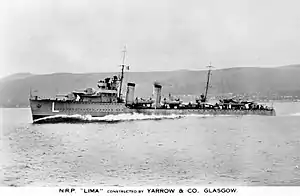NRP Lima (D333)
NRP Lima was one of five Douro-class destroyer built for the Portuguese Navy during the 1930s. She remained in service until the early 1960s.
 Lima | |
| History | |
|---|---|
| Name | Lima |
| Namesake | Lima River |
| Builder | Yarrow, Scotstoun |
| Launched | 29 May 1933 |
| Commissioned | 12 October 1933 |
| Fate | Stricken, early 1960s |
| General characteristics (as built) | |
| Type | Douro-class destroyer |
| Displacement | |
| Length | 323 ft (98.5 m) |
| Beam | 31 ft (9.4 m) |
| Draught | 11 ft (3.4 m) |
| Installed power |
|
| Propulsion | 2 shafts; 2 × geared steam turbines |
| Speed | 36 knots (67 km/h; 41 mph) |
| Range | 5,400 nmi (10,000 km; 6,200 mi) at 15 knots (28 km/h; 17 mph) |
| Complement | 147 |
| Armament |
|
Design and description
The Douro-class ships were designed by the British shipbuilder Yarrow and were based on Ambuscade, a prototype destroyer built for the Royal Navy in 1926 by Yarrow.[1] They were 323 feet (98.45 m) long overall, with a beam of 31 feet (9.45 m) and a draught of 11 feet (3.35 m). The ships displaced 1,219 long tons (1,239 t) at standard load and 1,563 long tons (1,588 t) at full load.[2]
The Douros powered by two Parsons-Curtis geared steam turbines, each driving one propeller shaft using steam provided by three Yarrow boilers. The turbines, rated at 33,000 shaft horsepower (25,000 kW), were intended to give a maximum speed of 36 knots (67 km/h; 41 mph).[lower-alpha 1] The destroyers carried enough fuel oil to give them a range of 5,400 nautical miles (10,000 km; 6,200 mi) at 15 knots (28 km/h; 17 mph).[2][4]
Armament was similar to contemporary Royal Navy destroyers, with a gun armament of four 4.7 in (120 mm) Vickers-Armstrong Mk G guns, and three 2-pounder (40 mm (1.6 in)) Mk VIII anti-aircraft guns. Two quadruple banks of 21-inch (533 mm) torpedo tubes were carried, while two depth charge throwers and 12 depth charges constituted the ships' anti-submarine armament. Up to 20 mines could be carried. The ships' complement consisted of 147 officers and men.[2]
Construction and career
The five destroyers carried out patrols to defend Portugal's neutrality during the Second World War. Their anti-aircraft armament was revised during 1942–1943, with the 40 mm guns and one of the banks of torpedo tubes replaced by six 20 mm cannon.[3][1] The ships were refitted by Yarrow from 1946 to 1949, with the machinery refurbished, anti-aircraft armament again revised to three Bofors 40 mm gun in powered mounts and three 20 mm cannon. Sonar and British Type 285 and Type 291 radars were fitted.[5]
Notes
- Lima reached 36.36 knots (67.34 km/h; 41.84 mph) from 31,110 shaft horsepower (23,200 kW) during trials.[3]
Citations
- Roberts 1980, p. 397.
- Whitley 1988, pp. 221–222.
- Whitley 1988, p. 222.
- "Portuguese Navy: Keels of Two Destroyers Laid". The Straits Times. 15 July 1932. p. 3.
- Lyon & Chumbley 1995, p. 317.
Sources
- Blackman, Raymond V. B., ed. (1960). Jane's Fighting Ships 1960–61. London: Sampson Low, Marston & Co.
- Griffith, Frank G. (1988). "Cover Photo and Miscellaneous comments". Warship International. XXV (2): 116. ISSN 0043-0374.
- Lyon, Hugh & Chumbley, Stephen (1995). "Portugal". In Chumbley, Stephen (ed.). Conway's All the World's Fighting Ships 1947-1995. Annapolis, Maryland: Naval Institute Press. pp. 317–322. ISBN 1-55750-132-7.
- Roberts, John (1980). "Portugal". In Chesneau, Roger (ed.). Conway's All the World's Fighting Ships 1922–1946. New York: Mayflower Books. pp. 396–398. ISBN 0-8317-0303-2.
- Whitley, M. J. (1988). Destroyers of World War Two: An International Encyclopedia. Annapolis, Maryland: Naval Institute Press. ISBN 0-87021-326-1.